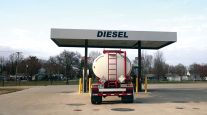Diesel Drops 1.8¢ to $2.928 a Gallon
This story appears in the June 21 print edition of Transport Topics.
The average price paid for U.S. retail diesel fuel dipped 1.8 cents to $2.928 a gallon last week, its fifth straight weekly drop that has lowered the price by 19.9 cents a gallon, the Department of Energy reported.
The average retail price for regular gasoline also declined, by 2.4 cents to $2.701 a gallon, DOE reported June 14 after its survey of fueling stations. Gasoline also has fallen for five straight weeks, by 20.4 cents a gallon, during the period.
The diesel average is now at its lowest point since mid-March, but analysts cautioned that the current run of declines could be ending, because crude oil has been rising steadily in recent weeks.
“The fall in crude prices has been the main driver in the decline in diesel and gasoline,” Tancred Lidderdale, senior economist for DOE’s Energy Information Administration, told Transport Topics. “There is a lag of a pass through from crude to the retail market, which is why both fuels are still falling, though crude has turned around and has been climbing in price.”
Crude oil closed at $77.67 a barrel June 16 on the New York Mercantile Exchange, Bloomberg News reported, up from its low for the year on May 20 of $68.01 a barrel.
While still below its high of the year of $86.84 set on April 6, crude has been trading over $70 per barrel since May 26.
“We’re getting to the point where this drop in retail fuel prices will stop or even go up,” Phil Flynn, senior energy analyst at PFGBest, Chicago, told TT.
EIA’s Lidderdale agreed. “We’re already seeing wholesale diesel prices start to rise,” he said. “For example, wholesale diesel prices hit their low point on May 20 to 25 at $1.80 a gallon, and then were moving upward to $2 a gallon in early June, while retail diesel prices are just now hitting the low point.”
Truckers were enjoying whatever advantages the near 20-cent drop gave them.
“Obviously, it’s an improvement to us as far as having cheaper diesel,” Phil Hammel, chief operating officer of Carter Logistics, Anderson, Ind., told TT. “When diesel is stable, that’s good for us and our customer base. Fuel is always a major impact” on the fleet’s economic performance.
Carter Logistics operates 600 of its own tractors, works with 70 owner-operators and owns 1,200 trailers, mostly dry vans, Hammel said.
“First of all, we’re always looking for a way to improve fuel economy, because I am not naïve enough to think diesel will continue to go down,” Hammel added. “There are a lot of areas of impact that we have control over, whether it’s tire inflation, the power unit itself, driver education or keeping idle time down. We have no control over prices or regulations, especially from California.”
Brian Kinsey, chief executive officer of Brown Trucking, Lithonia, Ga., said his company is experimenting with some new fuel-saving devices.
“Especially since we do a lot of non-highway driving, many fuel-efficiency approaches such as trailer skirts are not cost-effective,” he said. “However, we are trying super single tires and are considering putting flexible extensions on the back fairings of tractors.”
The company operates about 500 tractors, 271 of them by owner-operators, and owns 2,800 trailers. Some 85% of Brown Trucking’s business comes from dedicated runs of about 130 miles, carrying packaging and paper.
He said the tractor extensions are intended to decrease the air pocket that forms between the tractor and trailer and creates a drag on its operations.
Despite the recent drops, retail diesel was selling for 35.6 cents a gallon more than the corresponding week last year, while gasoline was just 2.9 cents a gallon more expensive, EIA said.
“I think diesel’s cost now is testament to the fact that the economy is doing better than a year ago,” PFGBest’s Flynn said. “Then we have the continued spread of ultra-low-sulfur diesel, which is more expensive to refine than the old diesel.”




